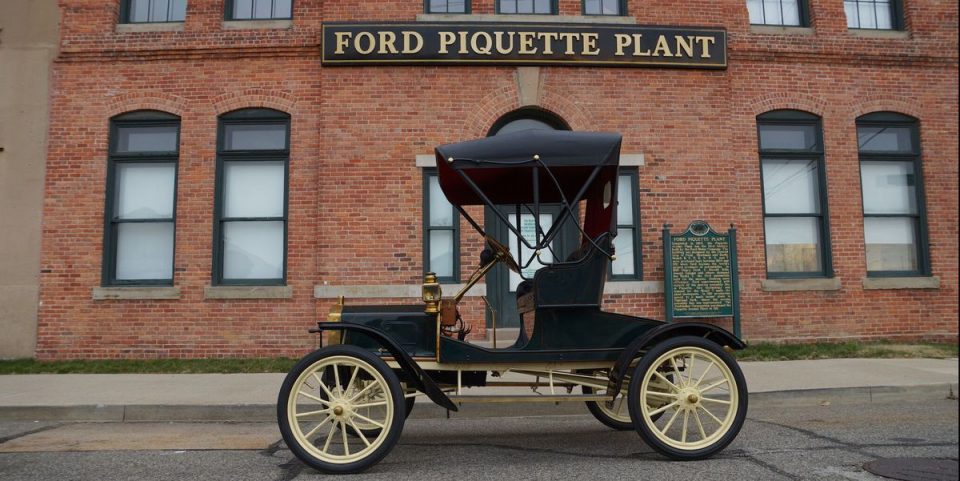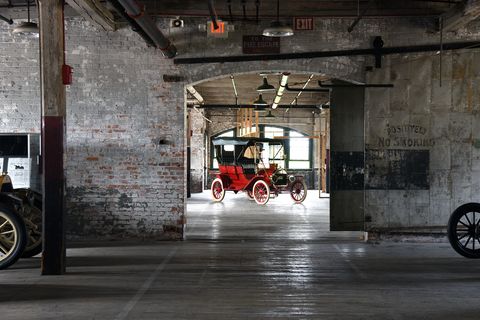Henry Ford changed human destiny when he introduced the Model T. Over its 19 year production run, more than 15 million were built, and the affordable motor cars helped put the world on wheels. For that reason, the Model T remains the unequivocal vehicle of the 20th century, cemented forever in history. And yet for all that we know about this icon of automobilia, very few people are familiar with the place in which it was born. That facility is known as the Piquette Avenue Plant, one of the oldest automotive manufacturing sites still in existence today.
Henry Ford’s automotive story didn’t begin with the company we know today. In fact, this current iteration of Ford Motor Company was Henry’s third attempt at building an automaker. That wasn’t an uncommon story in Detroit at the time, with literally hundreds of automakers booming and busting. Ford was destined to succeed however, and the Ford Motor Company started in earnest on June 16, 1903. During the early days of business, Ford rented production space inside a building off of Mack Avenue in Detroit. While Ford vehicles were built at that facility, it wasn’t owned by Ford outright. As business grew, Ford dreamed up plans for a new plant to call his own.
That building was constructed in the heart of Detroit’s Milwaukee Junction neighborhood, named for the rail lines that intersect at its center. The plant was positioned with easy access to parts and raw materials in mind. The location allowed finished cars to ship across the country too. This small part of the growing city would house operations for other notable automakers like Brush, Packard, Cadillac, and Regal. In this neighborhood, the Model T sparked to life.
Ford’s first plant was constructed at the corner of Harper and Piquette Avenue in April of 1904 at a cost of $76,500. Measuring 402 ft long and 56 ft wide, the three-story building is a far cry from a modern megafactory. While it may not look like much from the outside, The Piquette Avenue Plant was state-of-the-art in its day, complete with a 25,000-gallon fire suppression system, one of the oldest in the country. Electricity was another must for Ford, who previously had been the chief engineer at the Edison Illuminating Company. As such, the plant featured electric lights and an electric elevator on which employees would enter the facility. It’s worth noting that roughly 10 percent of Detroit residents had electricity at the time of the plant’s construction.
When the Piquette Avenue plant first opened in 1904, it housed a few hundred employees. As production methods changed and output grew, that figure swelled dramatically, according to Piquette Avenue historian Tom Genova. There were so many people working at the small Piquette plant that Ford actually had to build several outbuildings on the property to house parts of the operation. Ford’s Models B, C, F, K, N, R, and S were all engineered and built at the facility, with the Model N taking the national sales title in 1907. Ford and Piquette were officially big players in the burgeoning car business.
With his business growing, Henry Ford began a top-secret project at Piquette. The business magnate had a section of Piquette’s third floor walled off to house a skunkworks team, hand-selecting the best and brightest within the company for the task. Among these folks were Ed “Spider” Huff and a 14-year old Edsel Ford, who would utilize a Model N as a testbed for a new machine. Forgoing the advice of investors who wanted more expensive, high-profit cars to sell, Henry and his team poured themselves into trying to cut customer costs while improving the Model N.
The Ford Model T made its debut to the world on October 1, 1908. The first production example, which arrived for the 1909 model year, left the Piquette Avenue Plant on September 27, 1908. The car was an immediate success — Ford took thousands of orders in the following weeks. During the first year of sales alone, Ford moved 10,066 Model Ts.
The Model T was brutally simple, designed to be lightweight, inexpensive, and easy to repair. Up front sat a 2.9-liter inline-four with a one-piece engine block, which produced 20 hp. A two-speed planetary gear transmission backed the motor, complete with a reserve gear. The Flywheel magneto ignition system also helped to keep costs down, while providing the added benefit of opening up your choice of fuel beyond gasoline. Unlike some automakers at the time who aired on the side of rigid chassis and body structures, the Model T was intended to flex and twist as it bounded over the miserable roads of the early 1900s. More importantly, the Model T was cheap, carrying a base price of just $825, or a bit more than $24,000 today.
Of the 15 million or so Model Ts that were built, approximately 12,000 would enter the world through the doors at Piquette. During that first year of production, the plant became the first in automotive history to build more than 100 vehicles in a single day.
There are a few ways to identify a Model T that was built at Piquette. For starters, you can look on the radiator for the badging, which was unique. Unlike later variants, Piquette cars feature long tails on both the first and last letters of Ford. The difference in value that those wings bring on the market today is staggering. A Model T wearing colored paint (instead of the ubiquitous coat of black) may also be a Piquette native, but it is a misnomer to say that’s always the case. Ford’s famous black paint policy didn’t officially take effect until after the automaker had already left Piquette, with some painted examples actually being built at Highland Park.
The completion of Ford’s Highland Park facility in 1910 spelled the end for Piquette Avenue. The enormous Highland Park cranked out an incredible number of vehicles thanks to Ford’s implementation of the moving assembly line. By 1913, Highland Park was able to build a Model T from soup to nuts in just 93 minutes. It previously took more than 12 hours to finish a car at Piquette. Ford’s move wasn’t the end of Piquette’s place in automotive history though, as Studebaker would go on to utilize the facility from 1911 to 1933.
The Piquette Avenue Plant would then fall into the laps of several other companies before ending up in private hands in 1989. By that point the facility had fallen into disrepair, and talks around the city began to swirl about its destruction. Thankfully for us gearheads, the Model-T Automotive Heritage Complex purchased the site in 2000. Now known as the Ford Piquette Avenue Plant, this 501(c)(3) non-profit now operates the site as a museum. As the Motor City continues to turn things around, the museum hopes to be a part of how Detroiters visualize that future.
“Henry Ford was a disruptor,” said museum president Jill Woodward. “If you think about the vehicle manufacturing, you have to look at what else was going on around it. The Great Migration had its origins here. The rise of the middle class and their access to automobiles all started right here upstairs. Henry Ford had a series of innovations over the course of his life, from the Model T to the V-8, and that’s a rare example of entrepreneurship. That’s a quintessential Detroit story. And so we see ourselves as a cultural resource for the city, and a point of pride for the city.”
The museum itself is certainly something to be proud of, housing an incredible collection of early American automobiles. In fact, Piquette is one of the only places on Earth where you can see the entire Ford “Alphabet” collection on display together. The volunteer team have worked for more than two decades to restore the building to its proper glory, utilizing correct materials and practices along the way. That level of dedication is felt when you visit, and it’s no surprise that the team is currently engaged in talks about becoming a UNESCO World Heritage Site, pending some (costly) upgrades.
Whether or not the early days of the auto industry tickle your fancy, the Piquette Avenue Plant should make every enthusiast’s bucket list. Ford’s work there reshaped the entire fabric of our society. Piquette put the world on the wheels, and we never looked back.









